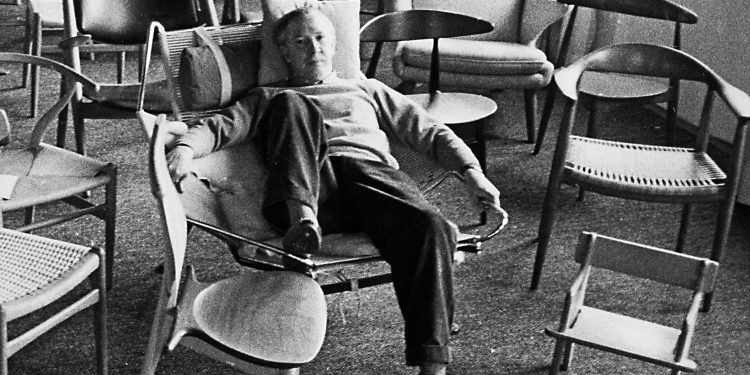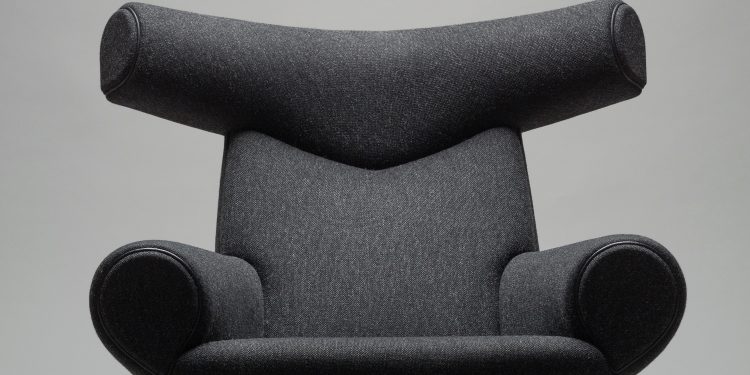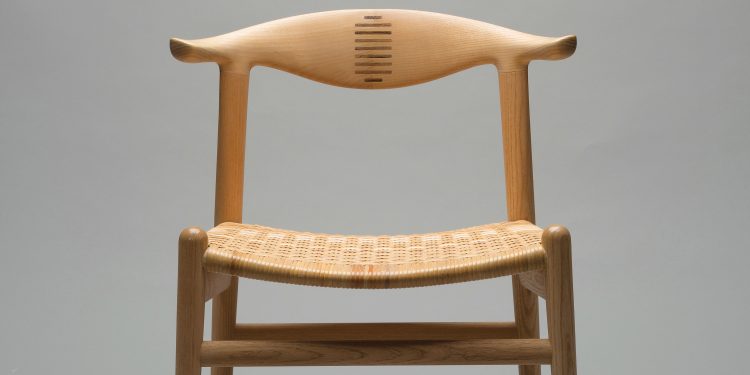Wegner, Denmark’s King of Chairs, was never satisfied!
“If only you could design just one good chair in your life . . . But you simply cannot.” (Hans J. Wegner, 1952). Hans J. Wegner was never quite satisfied, always striving to create the perfect chair (he designed more than 500 chairs) and perhaps this is the secret for his enormous success.
The article continues below.
Hans. J. Wegner (1914-2007) became extremely important in the development of the concept “Danish Design”.
It was his furniture that paved the way for Danish Design’s international breakthrough in the years following World War 2. He also became a leading figure in Organic Modernism, which was developed in the aftermath of the war and had its heydays in the 1950s. Organic modernism replaced the early modernism’s rectilinear (very straight), angular forms with soft, curved shapes.
The movement was inspired by the shapes of plants and the human body, as well as the functionally based “power line forms” in cars, trains and air-planes. Wegner was recognised for providing the movement with organic and natural softness.
He was one of history’s most productive designers. Designing and working until he turned 79; with more than 2,500 designs and 1,000 sketches show the extent of his creative ideas. The many chair designs were the background of his nickname the King of chairs or just The Chair Maker, Stolemageren, as a documentary by the Danish Film Institute about him was named.
The article continues below.
The global breakthrough
In 1949 he created a chair, which the Americans were to name simply ‘The Chair’. The chair itself was actually a redesigned version of a Chinese chair, which was simplified and beautified by Wegner thereby turning it into a more typical Danish design – making it extremely functional and adding a comfortable round back.
Naturally, the popularity of the chair grew immensely when it was exposed on American TV in 1961. This occurred during a live TV transmitted debate where the presidential candidates Richard Nixon and John F. Kennedy each sat on ‘The Chair’.
This was long before Danish television had ever heard of advertising, or the modern term product placement, but it was in fact at this moment that Danish Design really appeared on the global map.
The article continues below.
A boy’s love of wood
Hans J. Wegner was born in 1914 in the Danish town of Tønder, located in the south of Jutland, not far from the German border. He was the son of a shoemaker and grew up with a love of wood and craftsmanship.
In 1932, he finished his craftsmanship as a carpenter, and later studied furniture design at The Danish Furniture School in Copenhagen. Founded by Professor Kaare Klint in the 1920s, The Danish Furniture School had set out to build on traditions.
The students studied Design Museum Denmark’s collection of historic furniture from different cultures and eras, refining and adapting them to fit with contemporary needs.
The article continues below.
Modern design with a classic twist
Wegner worked his whole life to making the perfect chair. He made new modernist furniture and also found inspiration from old Chinese and English chairs. He not only simplified them, in order to enhance their artistic expression, but also made them more suitable for industrial or mass production.
Denmark was late in becoming an industrial nation, and had retained a great deal of traditional craftsmanship. The majority of Wegner’s most ground-breaking ideas were presented at Design Museum Denmark’s annual Joiners’ Guild Exhibition.
The exhibitions became paramount in the initial development of Danish Design, especially as American journalists came to see the quality of Danish furniture art and began to write about it.
What was special about Wegner, as a Danish designer, was his ability to develop classic design ideals into something completely new, often finding inspiration in centuries-old handcrafts. Wegner made his impact on Organic Modernism with his organic shapes, inspired by ancient tools such as axe-handles and oars.
Being primarily a carpenter, then a designer, Wegner’s work always took its starting point in craftsmanship. He produced nearly all his own prototypes in the workshop. He had a persistent curiosity for the potential of different materials and a deep respect for wood and its character.
He succeeded in showing the modern world that the old virtues of craftsmanship, such as sensuality, beautiful detailing, and the use of natural materials, do have a place in the modern industrialised world.
He weighted simplicity and comfort high and although Wegner’s approach to design was neither retrospective nor romantic, his furniture was nevertheless full of poetry. This is probably the reason why his designs, even while being wholly rational and grounded in functionality, have remained popular right up to the present day.
The article continues below.
Wegner in the 21st century
Even today Wegner’s chairs continue to be extremely popular. His most widely sold chair to date is the famous Wishbone Chair. Next time you have a whole chicken for a meal take a look at the wishbone, and you will see the shape that must have inspired Wegner.
The Wishbone chair, which was first launched in 1950, is still produced by the Danish furniture manufacturer Carl Hansen & Son.
Today it comes in a variety of colours and types of wood, even being remodelled by the British designer Paul Smith. Wegner’s works are exhibited at major international museums including; The Museum of Modern Art (MoMA) in New York, and Die Neue Sammlung in Munich.
The article continues below.
Wegner collections in Denmark
The art museum, Kunstmuseet Tønder, has a permanent exhibition of 37 of Wegner’s most iconic chairs. They were actually a donation from Wegner and his wife in 1995 and are believed to represent the chairs that came closest to his ideal of creating the perfect one. Read more at www.museum-sonderjylland.dk and then click on Kunstmuseet Tønder and look for Vandtårnet (water tower).
You can also visit the new showroom of Carl Hansen & Søn in Bredgade, Copenhagen. Here they exhibit their production of Wegner’s chairs as well as Kaare Klint’s famous safari chair and a range of other furniture designers. Entrance is free.
The wishbone chair –called Y stolen in Danish
Carl Hansen & Son have produced the wishbone chair since 1950. They are produced in a variety of woods and come in many colours. Prices range from DKK 4,000 to 8,000. They can be quite an investment, if you want six or even eight to fit with your dinner table. They can always be resold though.You can also buy them from an auction house. Here you typically save between 50 to 70 percent compared to the new ones. The quality varies from batch to batch as they are sold without having been renovated. In the many different vintage shops selling Danish Design furniture, you can save between 30 to 50 percent on the new price, as here they are often repaired before being put out for sale.
By Lene Arlund, Architect and interior designer
Pictures: Design Museum Denmark, Carl Hansen & Søn, Museum Sønderjylland/ Torben Eskerod
Sources: Design Museum Denmark, Kunstmuseet Tønder, Carl Hansen & Søn, “Stolemageren” by Lise Roos






